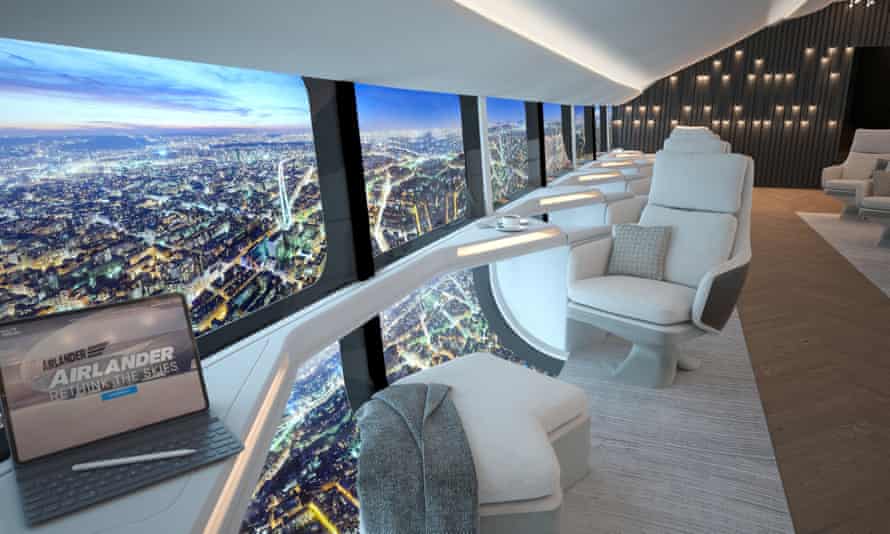Airships for city hops could cut flying’s CO2 emissions by 90%
Bedford-based blimp maker unveils short-haul routes such as Liverpool-Belfast that it hopes to serve by 2025

For those fancying a trip from Liverpool to Belfast or Barcelona to the Balearic Islands but concerned about the carbon footprint of aeroplane travel, a small Bedford-based company is promising a surprising solution: commercial airships.
Hybrid Air Vehicles (HAV), which has developed a new environmentally friendly airship 84 years after the Hindenburg disaster, on Wednesday named a string of routes it hoped to serve from 2025.
The routes for the 100-passenger Airlander 10 airship include Barcelona to Palma de Mallorca in four and a half hours. The company said the journey by airship would take roughly the same time as aeroplane travel once getting to and from the airport was taken into account, but would generate a much smaller carbon footprint. HAV said the CO2 footprint per passenger on its airship would be about 4.5kg, compared with about 53kg via jet plane.
Other routes planned include Liverpool to Belfast, which would take five hours and 20 minutes; Oslo to Stockholm, in six and a half hours; and Seattle to Vancouver in just over four hours.
HAV, which has in the past attracted funding from Peter Hambro, a founder of Russian gold-miner Petropavlovsk, and Iron Maiden frontman Bruce Dickinson, said its aircraft was “ideally suited to inter-city mobility applications like Liverpool to Belfast and Seattle to Vancouver, which Airlander can service with a tiny fraction of the emissions of current air options”.
Tom Grundy, HAV’s chief executive, who compares the Airlander to a “fast ferry”, said: “This isn’t a luxury product it’s a practical solution to challenges posed by the climate crisis.”
He said that 47% of regional aeroplane flights connect cities that are less than 230 miles (370km) apart, and emit a huge about of carbon dioxide doing so.
“We’ve got aircraft designed to travel very long distances going very short distances, when there is actually a better solution,” Grundy said. “How much longer will we expect to have the luxury of travelling these short distances with such a big carbon footprint?”
Grundy said the hybrid-electric Airlander 10 could make the same connections with 10% of the carbon footprint from 2025, and with even smaller emissions in the future when the airships were expected to be all-electric powered.
“It’s an early and quick win for the climate,” he said. “Especially when you use this to get over an obstacle like water or hills.”
HAV said it was in discussions with a number of airlines to operate the routes, and expected to announce partnerships and airline customers in the next few months. The company has already signed a deal to deliver an airship to luxury Swedish travel firm OceanSky Cruises, which has said it intends to use the craft to offer “experiential travel” over the North Pole with Arctic explorer Robert Swan.
Grundy said the company was in the final stages of settling on a location for its airship production line, which he hoped would be in the UK. He said the company would hire about 500 people directly involved in building the craft, and it would support a further 1,500 jobs in the supply chain. The company currently employs about 70 people, mostly in design, at its offices in Bedford. He said the company aimed to produce about 12 airships a year from 2025.
The craft was originally designed as a surveillance vehicle for intelligence missions in Afghanistan. HAV claims independent estimates put the value of the airship market at $50bn over the next 20 years. It aims to sell 265 of its Airlander craft over that period.
The £25m Airlander 10 prototype undertook six test flights, some of which ended badly. It crashed in 2016 on its second test flight, after a successful 30-minute maiden trip. HAV tweeted at the time: “Airlander sustained damage on landing during today’s flight. No damage was sustained mid-air or as a result of a telegraph pole as reported.”
The aircraft, which can take off and land from almost any flat surface, reached heights of 7,000ft (2,100m) and speeds of up to 50 knots (57mph) during its final tests. The company has had UK government backing and grants from the European Union.
SEE LA REVUE GAUCHE - Left Comment: Search results for AIRSHIPS
No comments:
Post a Comment